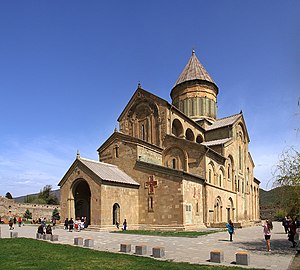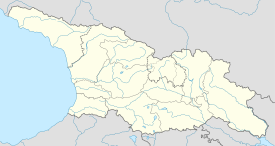Svetitskhoveli Cathedral
| Svetitskhoveli Cathedral | |
|---|---|

Cathedral seen in 2013
|
|
| Basic information | |
| Location | Mtskheta, Mtskheta-Mtianeti, Georgia |
| Geographic coordinates | 41°50′31″N 44°43′16″E / 41.8419°N 44.7211°ECoordinates: 41°50′31″N 44°43′16″E / 41.8419°N 44.7211°E |
| Affiliation | Georgian Orthodox Church |
| Architectural description | |
| Architect(s) | Arsukidze |
| Architectural type | Cathedral |
| Completed | 4th century (by King Mirian III) 5th century AD (during the reign of Vakhtang I) 1010–1029 (during the reign of George I) |
| Dome(s) | 1 |
| Official name: Historical Monuments of Mtskheta | |
| Type | Cultural |
| Criteria | iii, iv |
| Designated | 1994 (18th session) |
| Reference no. | 708 |
| Region | Europe |
The Svetitskhoveli Cathedral (Georgian: სვეტიცხოვლის საკათედრო ტაძარი, svet'icxovlis sak'atedro t'adzari; literally the Cathedral of the Living Pillar) is an Eastern Orthodox cathedral located in the historic town of Mtskheta, Georgia, to the northwest of the Georgian capital Tbilisi. A masterpiece of the Early Middle Ages, Svetitskhoveli is recognized by UNESCO as a World Heritage Site. It is currently the second largest church building in Georgia, after the Holy Trinity Cathedral.
Known as the burial site of Christ's mantle, Svetitskhoveli has long been one of the principal Georgian Orthodox churches and is among the most venerated places of worship in the region. The present structure was completed in 1029 by the medieval Georgian architect Arsukisdze, although the site itself dates back to the early fourth century.
Svetitskhoveli is considered an endangered cultural landmark; it has survived a variety of adversities, and many of its priceless frescoes have been lost due to being whitewashed by the Russian Imperial authorities.
The original church was built in 4th century A.D. during the reign of Mirian III of Kartli (Iberia). St. Nino is said to have chosen the confluence of the Mtkvari (Kura) and Aragvi rivers as the place of the first Georgian Church.
...
Wikipedia

